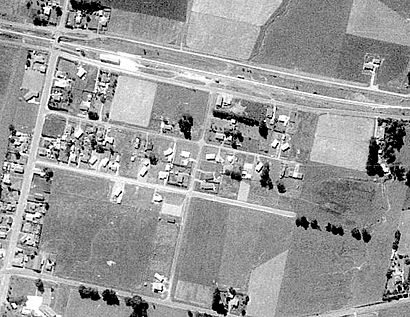Tokomaru railway station facts for kids
Quick facts for kids
Tokomaru railway station
|
|||||||||||
|---|---|---|---|---|---|---|---|---|---|---|---|

Tokomaru in 1982
|
|||||||||||
| Location | New Zealand | ||||||||||
| Coordinates | 40°28′11″S 175°30′31″E / 40.469753°S 175.508598°E | ||||||||||
| Elevation | 18 m (59 ft) | ||||||||||
| Line(s) | North Island Main Trunk | ||||||||||
| Distance | Wellington 118.56 km (73.67 mi) | ||||||||||
| History | |||||||||||
| Opened | 7 July 1885 | ||||||||||
| Closed | passengers 5 September 1971 goods 31 January 1982 |
||||||||||
| Services | |||||||||||
|
|||||||||||
Tokomaru railway station was a train stop in New Zealand. It was part of the main railway line called the North Island Main Trunk. The station served the town of Tokomaru in the Horowhenua District.
The station opened in 1885 and closed in 1982. Today, you can still see a small shed and a passing loop there. A passing loop is a special track that lets trains go around each other.
Contents
History of Tokomaru Station
The railway line near Tokomaru was built by March 1885. This was part of the Wellington and Manawatu Railway Company's new line. The station might have started moving goods in July 1885. However, regular passenger trains did not start until a year later.
A special train ran in April 1886. It went from Longburn to Ohau. Regular trains began running between Longburn and Ōtaki on August 2, 1886. Tokomaru was listed as a "flag station." This meant trains would only stop if someone waved a flag to get on, or if a passenger asked to get off there. The first train that went all the way from Wellington to Palmerston North ran on November 30, 1886.
Station Improvements Over Time
The station got many upgrades over the years. In 1893, a shed for goods and yards for cattle were built. These were made bigger in 1907. The station itself was also improved in 1909.
By 1911, Tokomaru station had several important features:
- A shelter shed for passengers.
- A platform to get on and off trains.
- A way for carts to reach the station.
- A goods shed, which was about 16.5 meters long and 3.6 meters wide.
- A loading bank for moving heavy items.
- Yards for cattle and sheep.
- A passing loop for trains. This loop was made longer several times. It started at 52 wagons in 1913, then 69 wagons, 90 wagons in 1940, and finally 101 wagons by 1948.
- A waiting room for ladies was added in 1911.
From 1908, a special system called a "tablet" was used. This was a safety system to make sure only one train was on a section of track at a time.
Railway Houses and Local Industries
Houses for railway workers were built near the station. These were put up in 1891, 1909, and 1927.
The Makerua Swamp was to the northwest of the railway. By 1903, about 18 kilometers of tramway tracks were laid there. These small tracks helped move goods. Many flax mills were also in the area. Flax mills processed a plant called flax. In 1906, six of these mills were within 1.6 kilometers of the station. One company, Swainson & Bevan, had its own tramway to the station from 1899 to 1909.
The North Island Main Trunk railway crosses the Tokomaru River about 2 kilometers south of the station.
By 1966, only two passenger trains stopped at Tokomaru each week. In 1981, the main things moved by train from Tokomaru were lime and fertilizer.
Images for kids



